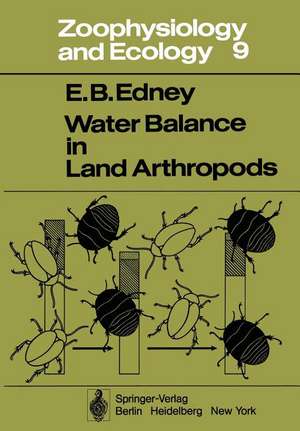Water Balance in Land Arthropods: Zoophysiology, cartea 9
Autor E. B. Edneyen Limba Engleză Paperback – 9 feb 2012
Din seria Zoophysiology
- 15%
 Preț: 647.92 lei
Preț: 647.92 lei - 15%
 Preț: 638.76 lei
Preț: 638.76 lei - 15%
 Preț: 638.24 lei
Preț: 638.24 lei - 15%
 Preț: 641.38 lei
Preț: 641.38 lei - 15%
 Preț: 634.82 lei
Preț: 634.82 lei -
 Preț: 386.61 lei
Preț: 386.61 lei - 15%
 Preț: 636.94 lei
Preț: 636.94 lei - 15%
 Preț: 640.88 lei
Preț: 640.88 lei - 15%
 Preț: 635.47 lei
Preț: 635.47 lei - 15%
 Preț: 637.78 lei
Preț: 637.78 lei - 15%
 Preț: 640.88 lei
Preț: 640.88 lei -
 Preț: 386.61 lei
Preț: 386.61 lei - 15%
 Preț: 637.78 lei
Preț: 637.78 lei - 15%
 Preț: 638.24 lei
Preț: 638.24 lei - 15%
 Preț: 642.83 lei
Preț: 642.83 lei - 15%
 Preț: 634.68 lei
Preț: 634.68 lei - 15%
 Preț: 642.83 lei
Preț: 642.83 lei - 18%
 Preț: 999.60 lei
Preț: 999.60 lei - 15%
 Preț: 639.41 lei
Preț: 639.41 lei - 15%
 Preț: 638.43 lei
Preț: 638.43 lei - 15%
 Preț: 651.34 lei
Preț: 651.34 lei - 15%
 Preț: 638.57 lei
Preț: 638.57 lei - 15%
 Preț: 637.46 lei
Preț: 637.46 lei - 15%
 Preț: 637.59 lei
Preț: 637.59 lei - 15%
 Preț: 641.53 lei
Preț: 641.53 lei - 15%
 Preț: 636.80 lei
Preț: 636.80 lei -
 Preț: 386.22 lei
Preț: 386.22 lei - 15%
 Preț: 632.55 lei
Preț: 632.55 lei - 15%
 Preț: 695.19 lei
Preț: 695.19 lei -
 Preț: 401.24 lei
Preț: 401.24 lei - 18%
 Preț: 942.01 lei
Preț: 942.01 lei - 18%
 Preț: 945.30 lei
Preț: 945.30 lei - 15%
 Preț: 652.17 lei
Preț: 652.17 lei - 15%
 Preț: 632.70 lei
Preț: 632.70 lei - 15%
 Preț: 640.71 lei
Preț: 640.71 lei - 15%
 Preț: 644.30 lei
Preț: 644.30 lei
Preț: 642.68 lei
Preț vechi: 756.09 lei
-15% Nou
Puncte Express: 964
Preț estimativ în valută:
122.97€ • 128.40$ • 101.78£
122.97€ • 128.40$ • 101.78£
Carte tipărită la comandă
Livrare economică 04-18 aprilie
Preluare comenzi: 021 569.72.76
Specificații
ISBN-13: 9783642811074
ISBN-10: 3642811078
Pagini: 300
Ilustrații: XII, 284 p.
Dimensiuni: 170 x 244 x 16 mm
Greutate: 0.48 kg
Ediția:Softcover reprint of the original 1st ed. 1977
Editura: Springer Berlin, Heidelberg
Colecția Springer
Seria Zoophysiology
Locul publicării:Berlin, Heidelberg, Germany
ISBN-10: 3642811078
Pagini: 300
Ilustrații: XII, 284 p.
Dimensiuni: 170 x 244 x 16 mm
Greutate: 0.48 kg
Ediția:Softcover reprint of the original 1st ed. 1977
Editura: Springer Berlin, Heidelberg
Colecția Springer
Seria Zoophysiology
Locul publicării:Berlin, Heidelberg, Germany
Public țintă
ResearchCuprins
1 Introduction.- A. General.- B. Terrestrial Arthropods.- C. Arthropod Structure.- D. Water.- 2 Water Content.- A. Total Body Water.- B. Water Reserves.- C. Location of Water Reserves.- D. Resistance to Desiccation.- 3 Water Loss—Cuticular.- A. Introduction.- B. Transpiration and Integumental Structure.- C. Ecological Implications.- D. Conclusions.- 4 Water Loss—Respiratory.- A. Introduction.- B. The Tracheal System of Insects.- C. Control of Respiratory Water Loss.- D. Spiracular Control Mechanisms in Dragon-Flies and Other Insects.- E. Intermittent Carbon Dioxide Release.- F. Respiratory and Cuticular Water Loss Compared.- G. Respiratory Water Loss in Arthropods Other Than Insects.- H. Conclusions.- 5 Water Loss by Evaporative Cooling.- A. Introduction.- B. Evaporative Cooling in Laboratory Experiments.- C. Evaporative Cooling in the Field.- D. Conclusions.- 6 Excretion and Osmoregulation.- A. Introduction.- B. Elimination of Nitrogenous Waste.- C. Osmotic and Ionic Regulation.- D. Hormonal Control of Water Balance.- 7 Uptake of Liquid Water.- A. Uptake of Water as a Result of Feeding.- B. Uptake of Water by Drinking.- C. The Question of Absorption Through the Cuticle.- D. Special Organs for Water Absorption.- E. Conclusions.- 8 Metabolic Water.- A. Introduction.- B. The Question of Regulation.- C. Respiratory Quotient and Metabolic Water in Locusta.- D. Metabolic Water in Flying Locusts and Aphids....- E. Conclusions.- 9 Absorption of Water Vapour.- A. Introduction.- B. Distribution of the Faculty Among Arthropods.- C. Limiting Conditions.- D. The Energetics of Absorption.- E. The Site of Absorption.- F. The Rate of Absorption.- G. Possible Mechanisms.- H. Conclusions.- 10 Water Balance in Eggs.- A. Structure.- B. Water Loss by Evaporation.- C. Water Uptake.- D.The Control of Water Uptake.- E. Uptake by Eggs of the Locust Chortoicetes.- F. Conclusions.- 11 Conclusions.- A. General.- B. The Components of Water Loss.- C. The Components of Water Gain.- D. Water Balance.- E. Osmotic and Ionic Regulation.- F. The Water Affairs of Eggs.- G. Water Balance and the Whole Animal.- H. Concluding Remarks.- References.- General Index.









